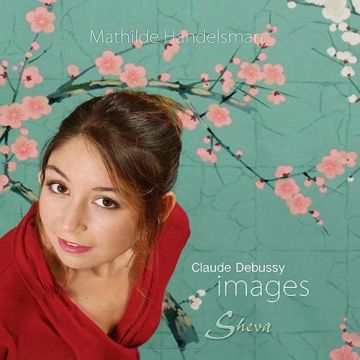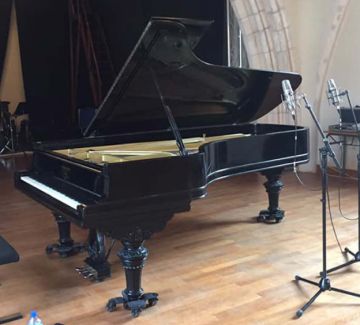Mathilde Handelsman, piano
Images, Book 1, L. 110
Estampes, L. 100
Images, Book 2, L. 111
Masques, L. 105
D’un cahier d’esquisses, L. 99
L’isle joyeuse, L. 106
Sheva Collection SH234
Release date: September 25, 2019
Giorgio Koukl | 24 SEP 2021
Claude Debussy (1862-1918) wrote his first book of Images between 1901 and 1905, so it is undoubtedly not exact to speak here of “youthful” works since the French composer was already over 40 years old.

album cover art
The three pieces of Images, Book 1 (L.110) are Reflets dans l’eau (“Reflections in the water,” D flat major), Hommage à Rameau (“Tribute to Rameau,” G sharp minor), and Mouvement (“Movement,” C major). Despite their formal tonality indication, these pieces are quite distant from whatever has been written for the piano until that moment, utterly free of any tonality status and justly considered the first examples of the Impressionistic style.
Debussy had a lifelong personal attraction to water, writing many pieces linked to it in some way. The image of moving water was a big help in depicting the idea he had in his head: a sort of liberation from the heavy musical style of Wagner taught in all of Europe and which until then dominated.
On her debut CD published by Sheva in 2019, Mathilde Handelsman is clearly able to catch the proper spirit of this music. Her capacity for phrasing and creating well proportioned dynamic shading are noteworthy. And her involvement in this particular period of musical history is quite palpable. A pity that all these efforts are partially destroyed by an imperfect sonic image and a too direct, quasi-dry sound. The choice of a historic Steinway piano, on the one hand, is understandable — Debussy could have played this instrument — but on the other hand, it is not well-paying. The extreme poverty of the sound is frustrating and certainly a handicap for somebody eager to show capacities of some fine playing. Debussy himself preferred the French pianos, especially the Pleyels or Erards, which possess a completely different sound.

The 1875 Steinway on which Handelsman recorded her debut CD. (courtesy of classical Music Communications)
Ms. Handelsman has some discreet technical abilities, which she displays effectively. For example, in the third piece called “Mouvement.” The capacity to play the quick repetitive notes, together with a certain lightness of touch, is certainly interesting when considered separately. The technical cleanness, in general, would perhaps still need some improvement.
The three pieces of Estampes (L.100), called Pagodes (“Pagodas”), La soirée dans Grenade (“Evening in Granada”), and Jardins sous la pluie (“Gardens in the rain”), all written in 1903, have all an exotic source of inspiration. The first piece signs a general interest in new musical material coming out of the different Asian colonies, especially the sound of Indonesian gamelan, which has enchanted many other composers of that period. It uses a pentatonic scale to mimic the traditional Asian style, at least to a certain degree. No European instrument could play the complex Asian harmonies, based on a different system of scales, like the Indian swaras, which never used the chromatic 12-tone system as established in Europe.
Despite his nearly zero experience with Spanish folklore, Debussy managed to invent a folk melody in the second piece, Evening in Granada, about which Manuel De Falla enthusiastically commented. The last piece is a very realistic and technically challenging description of a thunderstorm in Normandy.
Here Ms. Handelsman reaches the top of her technical abilities, and for me, this is also the best track of the whole CD.

Matilde Handelsman
The second series of Images follows, once again composed of three movements: Cloches à travers les feuilles (“Bells through the leaves,” in B major), Et la lune descend sur le temple qui fut (“And the moon descends on the temple,” that was in E minor), and Poissons d’or (“Goldfish,” in F sharp major), heavily influenced by a friend of Debussy, the sinologist Louis Laloy. Its contemplative character best suits the natural talent of Mathilde Handelsman to depict small, even tiny details with great accuracy.
Like L’isle joyeuse, the Masques was intended to be part of a suite called Bergamasque, which was never either printed or performed together, except perhaps the first times with the pianist Riccardo Vines.
This period of life was not an easy one for Debussy, which included separation from his first wife, Lilly, for Emma Bardac. The Masques, he declared, should not be considered as part of a comedy but instead like a dramatic description of his own turbulent life.
The last two pieces of this debut CD, in an ideal way, complete this period of life of the great French maestro: D’un cahier d’esquisses (L. 99) and L’isle joyeuse. These are just another occasion to admire the extraordinary capacity of Ms. Handelsman to catch the tiny details and not lose the overall picture while presenting nicely scintillating surfaces.
I personally dislike the last track because this is the only virtuosic piano piece ever written by Debussy and so a rare occasion to showcase the pianist’s capacities, but here, Ms. Handelsman loses a unique opportunity to deliver real fireworks by staying instead on the safe side.
In any case, there is enough musical finesse in her playing to justify a recommendation of this album, even bearing in mind that she has to compete with the greatest names of international pianism in this repertoire. ■
Giorgio Koukl is a Czech-born pianist/harpsichordist and composer who resides in Lugano, Switzerland. Among his many recordings are the complete solo piano works and complete piano concertos of Bohuslav Martinů on the Naxos label. He has also recorded the piano music of Tansman, Lutosławski, Kapralova, and A. Tcherepnin, amongst others, for the Grand Piano label. Koukl has most recently completed recording the solo piano music of Hungarian composer Tibor Harsányi.
(photo: Chiara Solari)
RECENT POSTS








.png)